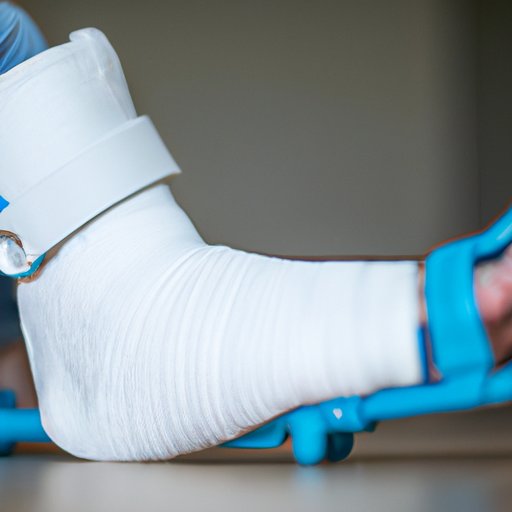
I. Introduction
Bearing weight on a broken ankle can be challenging and painful. However, it’s essential to follow your doctor’s orders and gradually increase weight-bearing to speed up recovery.
In this article, we’ll discuss how to safely bear weight on a broken ankle and the do’s and don’ts of weight-bearing. We will also explore the different stages of the healing process and potential risks associated with bearing weight too soon. Let’s dive in!
II. The Do’s and Don’ts of Weight Bearing on a Broken Ankle
Weight bearing refers to the amount of weight you can place on an injured limb without causing further damage.
It’s safe to start weight-bearing as soon as your doctor recommends it. Your healthcare provider will advise you on the amount of weight you can bear and for how long.
It’s crucial to follow your doctor’s orders and avoid putting too much weight on your ankle too soon. Failure to do so can lead to further injury and delay healing.
When bearing weight on a broken ankle, consider using crutches, a walker, or a knee scooter for additional support. You should avoid walking on uneven surfaces or slippery floors, and remember to wear sturdy, supportive shoes.
III. How to Safely Bear Weight on a Broken Ankle
If you’re ready to start bearing weight on your broken ankle, follow these steps:
- Begin by standing on your two feet with equal weight distribution on each foot.
- If you experience no pain, slowly shift most of your weight onto your uninjured foot and lift the injured ankle a few inches off the ground.
- Hold this position for 30 seconds, then repeat the process with a weight shift onto the injured ankle.
- Repeat 10 times.
In addition, doing ankle circles, writing the alphabet with the injured foot, or pressing your toes into the ground can help strengthen the ankle muscle and support the ankle joint.
In addition to exercises, you may need a brace, orthotic shoe, or ankle support to help stabilize your foot and provide additional support during weight-bearing.
IV. Understanding the Healing Process: Bearing Weight on a Broken Ankle
The healing process for a broken ankle varies depending on the severity of the injury. Generally, it takes between 6-12 weeks for a broken ankle to heal fully.
During the first 6-8 weeks, the focus of treatment is immobilization and protection. During this phase, you should avoid weight-bearing and keep your ankle elevated whenever possible.
After 8 weeks, your doctor may recommend starting gentle exercises to help slowly restore the range of motion and strengthen the ankle muscle. You can begin to bear weight on the ankle during this time.
It’s important to follow your doctor’s timeline for weight-bearing to avoid delayed healing or further injury. If you experience any pain or unusual swelling, contact your doctor immediately.
V. Alternatives to Bearing Weight on a Broken Ankle
In some cases, weight-bearing may not be possible or safe following a broken ankle. In these situations, you may need to rely on mobility aids to get around.
Some alternatives to weight-bearing include:
- Crutches, a walker, or cane
- Knee scooter
- Wheelchair
Your doctor can recommend the most appropriate mobility aid for your specific injury.
VI. Risks Associated with Bearing Weight on a Broken Ankle
It’s crucial to follow your doctor’s orders when it comes to weight-bearing. Failure to do so can lead to complications and delay healing.
Some risks associated with bearing weight too soon on a broken ankle include:
- Delayed healing
- Increased pain or swelling
- Further injury or fracture
- Development of arthritis or chronic pain
VII. The Importance of Follow-Up Care for Weight-Bearing After a Broken Ankle
Follow-up appointments with your doctor are essential for monitoring healing progress and adjusting your treatment plan as necessary.
During follow-up appointments, your doctor may recommend additional exercises or treatments to speed up healing and restore your mobility.
It’s crucial to attend all follow-up appointments and participate in any recommended treatments to ensure a full recovery.
VIII. Real-Life Testimonials: Bearing Weight on a Broken Ankle
Let’s hear from some people who have gone through the experience of bearing weight on a broken ankle:
“It was a long process, but gradually increasing my weight-bearing helped speed up the healing process. My doctor recommended exercises to help strengthen my ankle, and it was challenging but worth it in the end.”
“I couldn’t bear weight on my ankle for weeks following my injury, so I relied on crutches to get around. They were a lifesaver and allowed me to maintain my independence.”
“I thought I could handle more weight than my doctor recommended, and I ended up re-injuring myself. My advice – listen to your doctor and don’t rush the process.”
IX. Conclusion
Bearing weight on a broken ankle can be a challenging experience, but with the proper care and support, your ankle will heal. Remember to follow your doctor’s orders, gradually increase weight-bearing, and be patient throughout the healing process.





